

 HOME | ÍNDICE POR TÍTULO | NORMAS PUBLICACIÓN
HOME | ÍNDICE POR TÍTULO | NORMAS PUBLICACIÓN  Espacios. Vol. 37 (Nº 29) Año 2016. Pág. 13
Espacios. Vol. 37 (Nº 29) Año 2016. Pág. 13
Wallace Nóbrega LOPO 1; Gleison de Sousa AMORIN 2; Iranor Luciano LEITE 3
Recibido: 07/06/16 • Aprobado: 22/07/2016
ABSTRACT: This study is to demonstrate the coaching skills in the teaching of technology undergraduate courses in a higher education nonprofit. The work aims to describe the use of coaching skills by teachers of a higher education institution, located in the valley of Itajaí / SC, Brazil, assessing the knowledge: the use of discipline as motivation and encouragement; it stimulates the feedback and retains the ability to listen and consider. The research is characterized as qualitative and quantitative using as a case study procedure, based on an example of a higher education institution. As a research tool, applied a questionnaire containing 24 questions, open and closed, for 20 teachers of technology courses such as: logistics, management processes, information systems and human resources face. Already the result provides understanding that the goal has been reached and that the coaching skills are possible to obtain by teachers, being used by the same research institution |
RESUMEN: Este estudio quiere demostrar las habilidades de entrenamiento en la enseñanza de cursos de grado de tecnología en una organización no lucrativa de educación superior. El trabajo tiene como objetivo describir el uso de habilidades de entrenamiento de los profesores de una institución de educación superior, situada en el valle de Itajaí / SC, Brasil, la evaluación de los conocimientos: el uso de la disciplina como la motivación y el estímulo; estimula la regeneración y retiene la capacidad de escuchar y tener en cuenta. La investigación se caracteriza por ser cualitativa y cuantitativa usando como un procedimiento de estudio de caso, en base a un ejemplo de una institución de educación superior. Como una herramienta de investigación aplicado un cuestionario con 24 preguntas abiertas y cerradas, por 20 profesores de los cursos de tecnología, tales como: logística, gestión de procesos, sistemas de información y la cara de recursos humanos. Ya el resultado proporciona inteligencia de que el objetivo ha sido alcanzado y que las habilidades de entrenamiento son posibles de obtener por los profesores, siendo utilizados por la misma institución de investigación |
The educational market craves innovation and methods that draw the students to the classroom, not only to call these individuals, but also to keep them in there. Practicing coaching can be an effective tool to use in class (Knight, 2006). Coaching offers opportunities for innovation in the practice of teaching in a higher education institution, and the teacher may become a coach encouraging the students to reach higher goals and to go beyond the classroom knowledge (MATTEU, 2013).
Pennisi; Filho (2011) emphasize that for higher education institutions enjoy the potential of the coaché tool it is necessary to study and enhance the compatibility between the institution’s culture, the practices and assumptions of the coaching procedure. As well as encouraging coaching and aligning with appropriate reward systems (ELLINGER; ELLINGER; KELLER, 2003).
The role of the teacher and the coach are similar because both the teacher and the coach encourage people within a process to reflect the pursuit of enhancing their performance and individual or group learning and for personal and professional development. Law, Ireland and Hussain (2007) describe that coaching helps you learn, enhancing the performance of the individuals.
The research aims to describe the use of coaching skills by professors of a higher education institution in the valley of Itajaí / SC Brazil, evaluating the knowledge, if discipline is used as motivation and encouragement; if stimulates the feedback and retains the ability to hear and consider, the graduation courses of technology such as: logistics, management processes, information systems and human resources andclassroom courses of a non-profit institution located in the valley of Itajaí, SC Brazil, not being researched otherprofessors that do notbelong to the technology courses.
Coaching emerged as a tool to make possible or less conflicting the development of teaching and learning process between teacher and student (ALEXANDRE; RAMOS, 2015). The teacher as a coach should develop skills to provide the students with multiple ways of learning and understanding the practices that involve this process, both in pedagogy and psychology.
Coaching has emerged in the literature by management with its concepts associated with masters and apprentices in order to develop the individual in the various skills around the 1950s (ELLINGER; ELLINGER; KELLER, 2003). Coaching intends to facilitate the learning and development processes by equipping people with knowledge and associated tools to be developed and become effective in performance skills and personal attributes (BITTENCOURT et al, 2011; OLIVEIRA, 2012).
Through coaching, you can develop work teams in addition to making the most effective processes to meet the demands of the company (PENIDO, 2016). Vidal, Gordon and Ferrônio (2011) define that coaching is the process in which a mentor (coach) and a trained or a small group of people agree to work in harmony to achieve a set of objectives, through the development of a plan of action.
The International Coach Federation (2016) defines coaching as a process of cooperation between a coaching and coachee, which includes providing feedback in order to enhance their skills.
Coaching focuses on solving performance and behavior differences, promoting a link between coach (advisor), individual that applies the process, coachee (student), who gets the process (MASCHIO, 2015). Coaching is a tool that can be useful in the society and can train people with necessary skills for the development of the economy (KHALAJ; KHABIRI; SAJJADI, 2011).
Guimarães et al. (2013) and Whintmore (2003), emphasize that coaching helps unlock the potential of the individuals maximizing their potential. This tool works with combined stimulating: perseverance, strategy, flexibility, etc. (BEAN; DRAPER; HALL, 2010; GILBERT, Dubina, EMMETT, 2012). Coaching goes beyond training; dazzles empower the individual so that it turn your intentions into actions and translate them into results both in the professional field and personally.
The coaching process, for its educational nature is based on a series of principles and values that applied correctlycould help in the success of the participants in teaching and learning situations (LAREZ, 2008).
There are empirical evidences in the past that coaching can help teachers in the knowledge transfer, as well as in the practice into the classroom (KERTLOW; BARTHOLOMEW, 2010; Hartnett-Edwards, 2011). Anderson, Feldman and Minstrell (2014), in their research report that the purpose of coaching is to support professors at all levels of experience.
Larez (2008) describes in his research that coaching is a tool with very high application potential to increase the success of the participants during the development and conclusion of graduate work, because its nature contributes to the development of the individual.
First, the samples were defined. Secondly comes the development of the survey instrument. In the third stage, it is validated the research instrument. In the fourth stage, the research instrument is applied. After that comes the analysis of the results and finally in the sixth stage, comes the conclusion.
For research instrument validation, the tests were performed with the help of experts and professionals in the coaching segment previously selected. The research worked with questionnaires sent to 20 teachers via e-mail; having 100% return.
The study is characterized as qualitative and quantitative using as procedure the case study, taking as a basis for study, graduation courses in technology, such as: Logistics, Management Processes, Information Systems and Human Resources, all of them are in class and a non-profit educational institution located in the valley of Itajaí / SC, Brazil.
The survey instrument highlights the importance of work, and it included 24 questions. Initially we sought to identify the profile of the teachers as age, gender, title, length of service in teaching at the institution. The result of this preliminary research is shown in the following Graph 1:
Graph 1 – (a) Class and (b) Age

Source: authors (2016)
Graph 1 shows that just over half of the professors are male. Referring to age, 55% are between 25 and 45 having the highest percentage, taking the lower portion who is between 46 and 60 years old.
Graph 2 – (a) Title and (b) Service in the institution
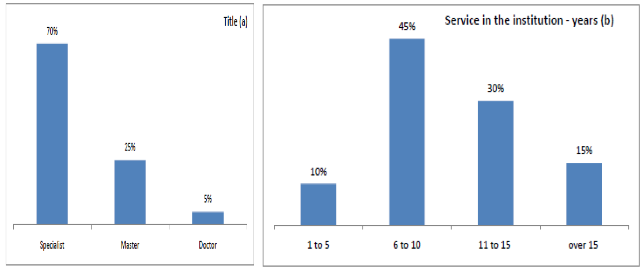
Source: authors (2016)
In Graph 2, experts and professors respondents represent 95% of the total amount. Referring to the length of service in teaching, 75% of respondents have up to 10 years of experience. As for the remaining 25% have more than 10 years of experience in teaching in the higher education institution researched. The survey also revealed that in its entirety the professors surveyed work in the night shift, during which these courses occur.
It is noticed that the team of professors has a significant percentage of experienced teachers, as follows: 75% are between 36-55 years of age, 30% are masters and doctors and 50% are between 06 to more than 11 years of experience teaching in the institution.
After identifying the profile of professors, it was evaluated the knowledge of their coaching skills. Initially it was made up a general framework for questions and answers that were analyzed according to questionnaire responses, which follows a classification of the five possible answers, which the following weights were assigned: 10 - No response; 20 - Never; 30 - Sometimes; 40 - Often; 50 - Always. It was used the mean,the variance and the standard deviation.
The means are described by question and appraiser. The questionnaire is divided into three parts: the first evaluates if the professor, "uses the discipline as motivation and encouragement." The second if the professor "encourages the feedback." "Retains the ability to hear and consider" is the third assessment, as the tables below.
Table 1 – Average per issue and per teacher.
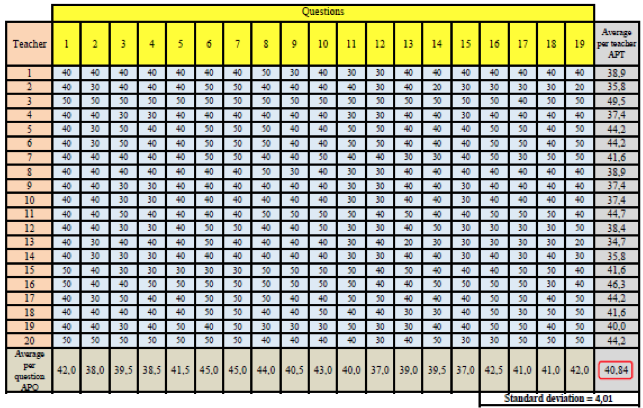
Source: authors (2016)
By the overall analysis of the mean per issue, it is clear that Q 12 and Q 15, had the lowest means. Q 6 and Q 7 obtained the highest means. The mean per professor, was at 40.8 and a low standard deviation.
Partially, it can be understood that the average score for question, the knowledge in coaching skills per professors of the higher education institution of technology courses ranged from 37 to 45. The mean per evaluator was 40.8, demonstrating a satisfactory knowledge and use of coaching skills by the professors.
The objective of the research is not only this, but also, describing the use of coaching skills by professors of an institution of higher education in the Valley of Itajaí / SC, Brazil, evaluating the knowledge using discipline as motivation and encouragement; if stimulates the feedback; and if retains the ability to listen and consider, which will be described in Table 2; 3 and 4 below.
Table 2 – Questions that assess knowledge of "use discipline as motivation and encouragement"
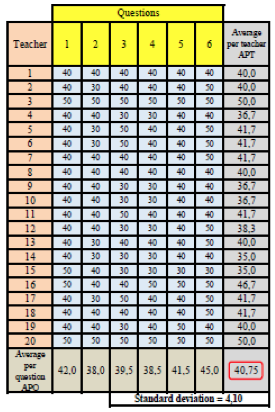
Source: authors (2016)
Table 3 – Questions that assess knowledge of "encourage feedback"
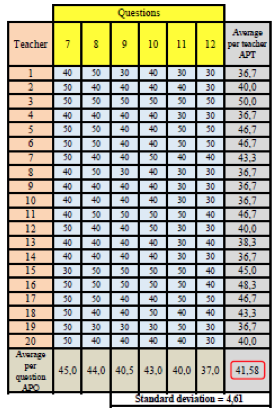
Source: authors (2016)
Table 4 – Questions that assess knowledge of "retains the ability to hear and consider”
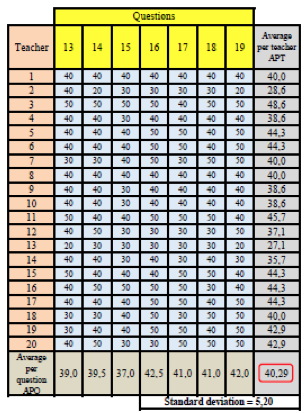
Source: authors (2016)
It is noticed that, in Table 2 the question 6, which refers to "clarify doubts of the students regarding their tasks?" got the highest evaluation. The question 2, which refers to, "I can keep students' interest in the maintenance and continuity of the dialogue?” had the lowest average per question. Regarding the mean per evaluator, it was at 40.8 and the standard deviation was also considered low, demonstrating a satisfactory balance between knowledge and use of coaching skills by teachers.
The question 7, which refers to "I clarify doubts of the students regarding their tasks?" achieved the highest rating and the question 12, which refers to "I exert influence on students expanding their competences in favor of effective results?" got the lowest mean per question. The mean per evaluator of Table 3 got a lower value; 39.94 with a standard deviation considered high 9.44, demonstrating a lower balance of knowledge and use of coaching skills by the professors, as shown in Table 3.
The analysis of Table 4 is related to the question 16, which refers to "I'm available to help the students when they are facing some academic and professional difficulty?" got the highest evaluation; the question 15, which refers to "I assume the responsibility for the development of the students?" got the lowest mean per question. The mean per evaluator, was 40.29 with a standard deviation slightly larger than the frame 2, but much smaller than the frame 3, but, still, considered low.
From the questionnaire division, one can understand that the affinities of the professors in relation to the use of coaching skills. This division consisted of three stages: the first one analyzed the use of the skill, use the discipline as motivation and encouragement, which had as APT (Average per teacher), the questions 1 to 6 = 40.77 and a standard deviation of 4.1. The second one analyzed the use of coaching ability, stimulates the feedback, which had as APT, the questions 7 to 12 = 39.94 and standard deviation of 9.44. The third one, examined the use of ability, retains the ability to listen and consider, which had as APT, the questions13-19 = 40.29 and a standard deviation of 5.2.
Making an analysis of Q2, Q3 and Q4, referring to the APT, the lowest mean was the Q3, describing that the professors still have full use of the coaching ability to stimulate the feedback. Considering the Q2, Q3 and Q4, were the ones that got higher average and very close, describing that the professorsbest useknowledge coaching skills, to listen and consider.
Making an analysis by the classification of the questionnaire weights that are: 10 - No response; 20 - Never; 30 - Sometimes; 40 - Often; 50 - Always, on the mean per evaluator, we have a satisfactory knowledge and use of coaching skills by the professors, since the overall APT was 40.8 and a low standard deviation, describing that, in general, all coaching skills are used by the professors.
In the standard deviation of Q2, Q3 and Q4, it is described that the Q4 had the highest oscillation, ranging in 5.2 around the APT, describing that the use of the coaching skill retains the ability to hear and is considered less use by the professors, or less regular. The most regular analysis was the Q3, which describes that the professors have more regularityin using the coaching ability to stimulate the feedback.
Therefore, it is concluded that the objective of this research was achieved. The use of coaching skills like: using discipline as motivation and encouragement; stimulating the feedback; and retaining the ability to hear and consider, are actually used by the professors of the higher educational institution studied, some of the skills with more frequent use and others with less use have been described.
It was also concluded that, based on the results of the research, coaching skills in higher education teaching, are possible to be obtained and used in the researched institution. Coaching is capable of making the development of the teaching and learning process among potential professors and students or less conflicting, for both the coach and the professor, both stimulate people within a process, for personal and professional development, individual or in group.
ALEXANDRE, T. M.; RAMOS, W. L. Coaching acadêmico: o processo de coaching no desenvolvimento do docente. Negócios em projeção, v. 6, n. 1, p. 28-38,2015.
ANDERSON, R.; FELDMAN, S.; MINSTRELL, J. Understanding relationship: maximizing the effects of Science coaching. Education Policy Analysis Archives, v. 22 n. 54, 2014.
BEAN, R. M.; DRAPER, J. A.; & HALL, V. Coaches and coaching in reading first schools: A reality check. Elementary School Journal, v. 111, n. 1, p. 87-114, 2010.
BITTENCOURT, J. P et al. Coaching para professores: desenvolvimento de competências docentes na área de Administração. XI Colóquio Internacional de Gestão Universitária na América do Sul: II Congresso Internacional IGLU. Florianópolis, 2011.
ELLINGER, A. D.; ELLINGER, A., E.; KELLER, S., B. Supervisory coaching behavior, employee satisfaction, and warehouse employee performance: a dyadic perspetive in the distribution industry. Human Resource Development Quarterly, v. 14, n. 4, p. 435-458, 2003.
MASCHIO, F. O processo de coaching e o alcance de metas: o estudo de caso de um empreendimento de bebidas. Global Manager, v. 15, n. 1, p. 69-84, 2015.
GILBERT, W., DUBINA, N., EMMETT, M. Exploring the potential of assessment efficacy in sports coaching. International Journal of Sports Science & Coaching, v.7, n, 2, p. 211-214, 2012.
GUIMARÃES, A. P et al. Perspectivas e Mudanças nas instituições de Educação de Ensino Superior. XIII Coloquio de Gestión Universitaria em Américas. Universidad Tecnológica Nacional. UFSC: nov 2013.
HARTNETT-EDWARDS, K. Helpgin the adults learn. Educational Leadership, v. 69, n. 2, p. 60-63, 2011.
FEDERATION, I. C. What is coaching. Disponivel em <http: //www.coachfederation.org/> Acesso em: 26 abr. 2016.
LAW, H., IRELAND, S., & HUSSAIN, Z. The Psychology of Coaching, Mentoring and Learning. Chichester, UK: John Wiley& Sons, 2007.
LÁREZ, H. J. H. El coaching educativo como estrategia para potenciar eléxito durante la etapa de desarrollo y culminación del trabajo especial de grado. Sapiens, v .9, n. 2, p. 219-234, 2008.
KERTLOW, A., BARTHOLOMEW, C. Using Coaching to Improve the Fidelity of Evidence-BasedPractices: A Review of Studies.Teacher Education and Special Education, v. 33, n. 4, p. 279-299, 2010.
KHALAJ, G., KHABIRI, M., & SAJJADI, N. The relationship between coaches leadership styles & player satisfaction in women skate championship. Procedia Social and Behavioral Sciences, v. 15, p. 3596–3601, 2011.
KNIGHT, J. Instructional coaching. The School Administrator, v.63, n. 4, p. 36-41, 2006.
MATTEU, D. A cultura coaching no ensino superior. RETC,v. 13, p. 97-105, 2013.
OLIVEIRA, R. K.M. Coaching teen: coaching com PNL: potencializando futuras pessoas de sucesso. Rio de Janeiro: Qualitymark, 2012.
PENIDO, C. O Líder-Coach e Sua Efetividade no Processo de Aprendizagem Comportamental. Gestão. Org, v. 13, n. 2,p. 103-115, 2015.
PENNISI, R. M. C; FILHO, R. R. P. As ferramentas de coach no desenvolvimento de competências especificas e outras diferenciações para a educação superior. OBSERVATORIUM: Revista Eletrônica de Geografia, v.2, n.6, p. 68-76, 2011.
VIDAL, M.; CORDÓN, E.; FERRÓN, V. Efectividad del coaching enlosprocesos de mejora de gestión de empresas. Universia Business Review, v. 1, v. 31, p. 82-101, 2011.
WHITMORE, J. Coaching:el Método para MejorarelRendimiento de las Personas. Barcelona: Paidós, 2003.1. Mestrando do Programa de Mestrado Profissional em Engenharia de Produção, Centro Universitário Sociesc – UniSociesc, Joinville, Brasil, e-mail: w.lopo@uol.com.br
2. Mestrando do Programa de Mestrado Profissional em Engenharia de Produção, Centro Universitário Sociesc – UniSociesc, Joinville, Brasil, e-mail: amorimlogistica@hotmail.com
3. Mestrando do Programa de Mestrado Profissional em Engenharia de Produção, Centro Universitário Sociesc – UniSociesc, Joinville, Brasil, e-mail: iranorleite@terra.com.br